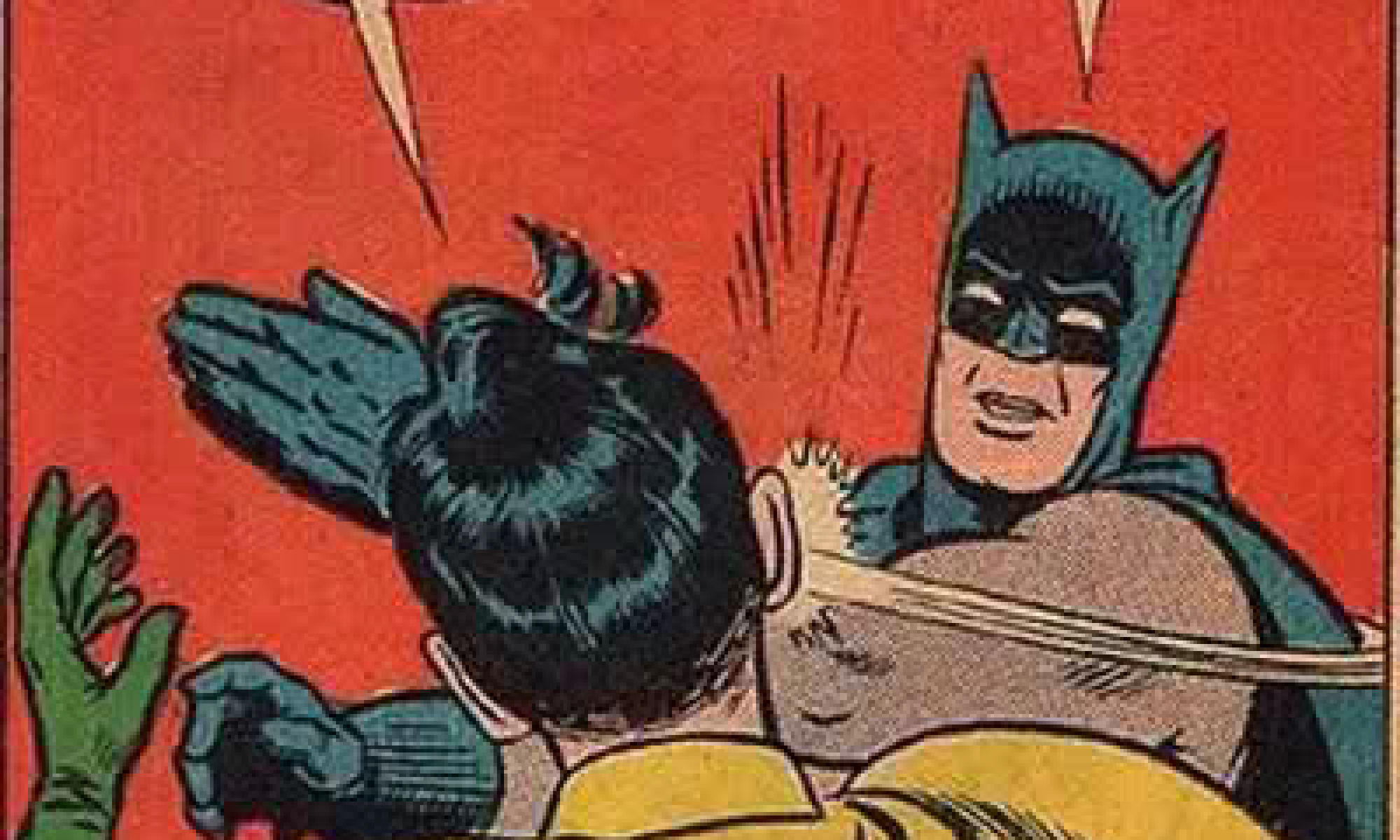The Mysterious Barricades
François Couperin’s piece for harpsichord Les Barricades Mystérieuses has caught the imagination of many. In these pages I discuss the piece and its title and gather its echoes in music, fiction, non-fiction, poetry, the visual arts, film, and performance.
Frank Stein and the B.G. System was a progressive Swiss rock band from the 1960s. In 1969 they released a single called Harpsichord on the Rock which featured “My Lady” (an anonymous 15th century keyboard piece) on the A side and, on the B side, “Mysterious Barricades.”
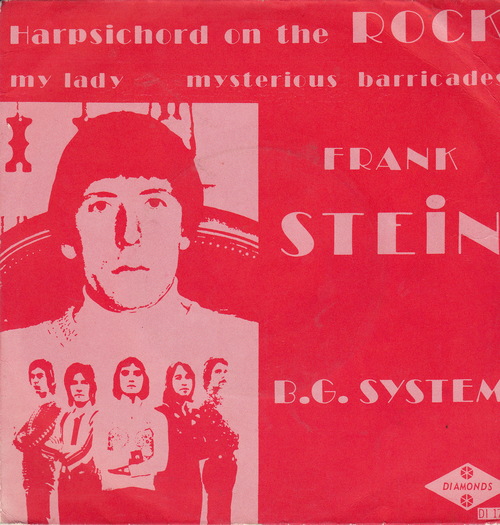
Jessica Wood comments, on her website:
This performance makes the Mysterious Barricades sound a little too much like Pachelbel’s Canon for my taste, partly because of the plodding tempo. Stein’s decision to stagger left and right hand on beat 4 of seemingly every measure also gets kind of old. But I appreciate that he created some variety in timbre by using the instrument’s different stops.
(Thanks to Jessica Wood for the soundfile of this piece.)
In 1971, the Moog synthesist Ruth White (b. 1925) released an album called Short Circuits which includes versions of a number of favorite classics. Among them is a rendition of “Les Barricades Mystérieuses” which, under the title “Variations on Couperin’s Rondeau (“Les Barricades mystérieuses”),” is the only piece on the album which deviates enough from the original for her to credit the result to herself.
Her variations involve the piece, played quite quickly, with a descant over the top playing a jaunty medley of bits and pieces, including some of Yankee Doodle. The result is actually rather pleasant. The cover is notable for its psychedelic art.
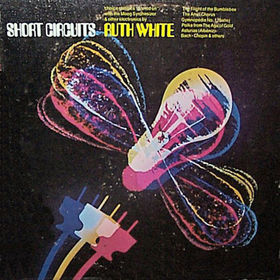
According to Elizabeth Hinkle-Turner (Women Composers and Music Technology in the United States, Ashgate, 2006, p. 37), White studied with George Antheil from 1951-4 (one of only three students of his). She founded The Electronic Music Association in the 1970’s with Paul Beaver. Her first studio was self-built and was on display at the Kenneth G. Fiske Museum for Musical Instruments at the Claremont Colleges. (Apparently, the studio has been moved to the Musical Instrument Museum in Phoenix, AZ though their site has no information about it.) More details of her career can be found on this web site, from which I take this awesome picture of White in her studio:

1973 was the year in which organist, harpsichordist and composer Anthony Newman‘s album Bhajebochstiannanaswas released. (The title is an anagram of “Johann Sebastian Bach,” whose music features on the album prominently.) Among the several original compositions is “Barricades (Rock piece after Couperin).” Newman’s note, from the album cover, tells us:
Barricades is like folk rock… [It] is a song of mine with underlying “changes” by the 18th-century composer François Couperin. The work intabulated is the well-known Barricades Mistérieuses from the sixth ordre for harpsichord.
The performers are Celia Pryor (vocals; the liner notes also credit her with the arrangement of the piece), Jaime Austria (bass), Anthony Newman (keyboards), David Cox (drum) and Bob Mann (guitar). The words are by Mary Jane Newman:
Winds of my dreams blow through my mind, my thoughts are floating. Clouds winds blow the clouds, clouds block my sight and gaze at lonely nights. The night is long to come so far fleeing lost in my dreams; waking, sleeping, lost in realities scenes. I’m tangled in patterns not of my doing. Winds of my dreams blow through my mind, my thoughts are floating. Clouds winds blow the clouds, clouds block my sight and gaze at lonely nights.
Let me ask you the question that taught me, ‘Can I end this dream?’. Winds of my dreams blow through my mind, my thoughts are floating. Clouds winds blow the clouds, clouds block my sight and gaze at lonely nights.
The dreams clouds are lifting, real visions are breaking through. I see, I feel, I touch, I’m real. I love, I see you there. The winds can’t hurt me now. I’m free. Break through the dream, after the pattern, true life with visions of change. Look to your spirit; new worlds are in your mind. Winds of my dreams blow through my mind, my thoughts are floating. Clouds winds blow the clouds, clouds block my sight and gaze at lonely nights.
Here are the piece (thanks to the Digital Media Services Lab at University of Miami for their help in converting the track to digital form and to Tony Newman for permission to post), the cover of the printed score, with artwork by Boyd Pryor, and the cover of the album, artwork by Guy Billout (and posted with his permission):
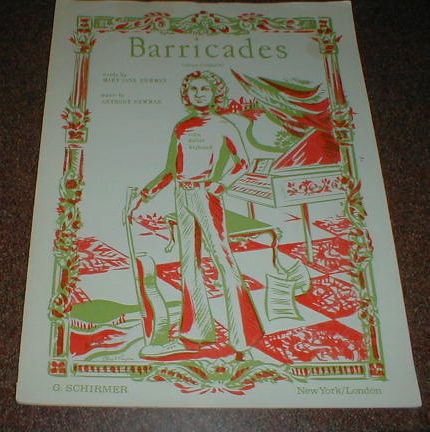
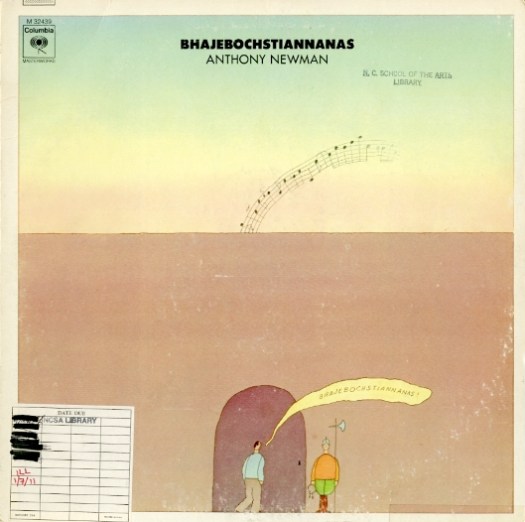
The composer Sergio Barroso (b. 1946) has a piece Las Barricadas Misteriosas from 1982. Of the piece, the composer writes (in a personal communication):
It was composed as a set of variations of the entire Couperin piece, that is, not just the theme as is usually done. I played the piece on a Sinclavier and, using a sort of organ-type sound, generated with this instrument many variations by compressing, stretching, distorting, etc the whole recorded material.
To give you an idea the compressing processes for example reduced the original piece in different manners but in one case to just a few seconds in the form of chordal attacks.
Later on selected variations were assembled into 15 continuous sections at time consisting of several variations superimposed, that is, set as materials in a polyphonic texture.
Up to 8 stereo tracks were assembled for an output in 4 channel stereo. The total duration is if I remember well about 15-16 minutes.
Here is the piece, in a re-edited version from 2011 that lasts about 13 mintues (posted with the composer’s permission) :
The Juilliard composer Andrew Thomas (b. 1939) wrote “Les Barricades Mysteriéuses” in 1984. It was written for, and used texts by, the poet and disabled activist Christopher Hewitt (1946?-2004). The work is scored for women’s chorus, piccolo, bassoon, harpsichord, & clapping.
In 1986, the British jazz composer and saxophonist, Barbara Thompson, released her album Heavenly Bodies. It contains the Appia Suite, five movements based on five paintings by the Swiss artist Dominique Appia, a reproduction of one of whose paintings Thompson came across by chance in an art store in Berlin. One of Appia’s paintings is called “Les Barricades mystérieuses” and one of the pieces in Thompson’s suite, inspired by the title and the painting, also bears that name.
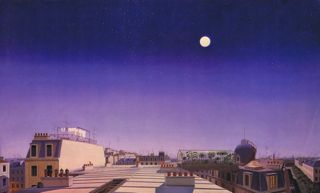
(Posted with the permission of the artist. See the Visual Arts page of this site for more details and a larger reproduction.)
Thompson’s “Les Barricades mystérieuses” exists in two other arrangements. In 1986, it was recorded by Thompson and the NDR orchestra for the title track of the German film Zischke. In 1997, in an arrangement for sax and string quartet by David Butler, it was recorded by Thompson and the Medici String Quartet on the album George Martin Presents the Medici Quartet (1997). Here is the version for sax and string quartet (posted with the permission of the composer):
Ex-Police guitarman Andy Summers‘ album Mysterious Barricades (1987) takes its name from its second track. The only possible audible relation the piece bears to the original is its incorporation of a kind of rhythmic ostinato in 4/4 time. Summers’ piece, however, is slow and spacey, quite the opposite in mood to the Couperin. Interestingly, though, given the appeal of Couperin’s piece to surrealists, Summers dedicates his album to Erik Satie.
The composer Philip Corner (b. 1933) has made frequent and creative use of Couperin’s piece which formed, for a time, part of his daily musical mediations. In personal communication, he said:
After the Middle Ages (say, Leonin & Perotin) it is only in the Baroque period (and before the 20th Century) that you find the kind of sustained textures and moods which permit a deeply inner rather than dramatic responsiveness. The clearest expression of this is in those patterned harmonies which move independent of any accompanying melody—as in a few preludes of Bach; and the greatest of these is/are Les Barricades Mystérieuses of François Couperin. I am convinced that he knew he was onto a mystical truth there. When I was improvising daily as a private spiritual practice I often used this piece as a vehicle (I had a few other ‘entries’)—-my own ‘Lord’s Prayer’ or ‘Shema Yisroel’ [inserted: or ‘Allah Akbar’ or ‘Hari Krishna’ or ‘Nam Ryoho Renghe Kyo’ or ‘I Am A Bubble Make Me The Sea’….Myra Hess used ‘Jesu Joy of Man’s Desiring’ but until Satie’s ‘Vexations,’ Couperin’s composition is the purest mantra in Western music.] The Mysterious Barricade (I am convinced) is the breakthrough from material consciousness to enlightenment.
On the basis of his daily improvisations, he developed Through the Mysterious Barricade which is, as he says, not “a composition in the ordinary sense, but a principle which can be manifested in various ways.” A score (available here) was published in 2003 that bears the following history of the ‘principle’:
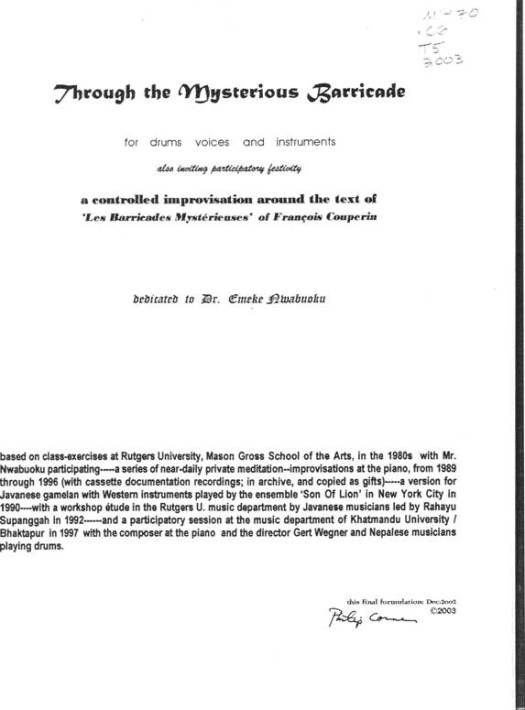
In correspondence, Corner states that the published score is close to the class exercises at Rutgers with Emeka Nwabuoku (1938-2006), to whom it is dedicated. Of the near-daily meditational improvisations, here are three versions recorded by Corner. The first, the full title of which is “Through the Mysterious Barricade (after F. Couperin) LUMEN I (for Stan Brakhage)” was recorded on the night of January 27, 1990 (in a loft on Leonard St). Corner had recently seen some of the films by Stan Brakhage and the improvisations of this period reflect their influence on him. (“LUMEN” in the titles of these improvisations picks up on the title of Brakhage’s film “The Riddle of Lumen.”) Corner sent this improvisation to Brakhage as a consequence of which Brakhage made his film Passage Through: A Ritual which uses Corner’s improvisation as its soundtrack. The music in the LUMEN I version blends with a “repetitive street-warning signal coming in from outside.” The pieces lasts about 42 minutes and the Couperin is played starting around the thirtieth minute. In almost all of the versions of “Through the Mysterious Barricade” the Couperin is played very slowly, but never more so than in this version, in which it takes about 10 minutes. The effect is startling, the music sometimes slowing down so much as almost to be unrecognizable.
A version for gamelan with western instruments, which, as Corner notes, is “more of a composition than an improvisation” was published in the scorebook Especially for Gamelan and is available from Frog Peak Music (who publish Corner’s music generally) or the American Gamelan Institute. It was performed by Gamelan Son of Lion, a group of which Corner was one of the co-founders. The workshop at Rutgers with Javanese musicians in 1992 also uses gamelan instruments, played by STSI Surakarta. You can listen to it here:
Finally, here is the session at the University of Katmandu, in Bhaktipur, “in which a version was realized closer to the concept of the African drum composition [the original Rutgers class-exercises from the 80’s].” It was recorded on October 15, 1998 and involves intoning and drums along with the piano. The rendition of the Couperin, in this version, is accompanied by drums and clapping and acquires a kind of rhythmic drive lacking in the other renditions by Corner.
In 2011, Philip Corner returned to the piece by Couperin and composed “Petite fantasie sur Les Barricades Mystérieuses (déjà une révélation) d’après François Couperin.” This piece is available from Frog Peak publishers here.
Finally, we may present this harmonic analysis of Couperin’s piece written by Corner for this site:
Une petite introduction (level Music 101) to the functional harmonies of French classical music as exemplified by “Les Barricades Mystérieuses” of François Couperin.
note well: I do not usually favor an indiscriminate use of academic Roman numeral chord analysis but in this case it serves the point. A very minuscule point, i might add, in dealing with the content of this marvelous piece…….just to demonstrate one small but crucial thing. In any case, i forbid anyone to mark up their scores the way i had to my Beethoven sonatas!
The composition is in Bb Major. (One hardly needs to read music to see that)
The first chord is the tonic, a perfect triad on Bb. I. ofcourse.
The chords change in a harmonic rhythm of half notes. That’s obvious too.
The 2nd one is on F, the bass in root position. Which makes it the Dominant. V.
Back to that Bb and the key is clinched. So onwards now……this time the dominant has a 7th in it; and that helps it to start moving. Resolution to G (G minor = vi) from where the sequence continues, paralleling the 4ths downward, which must as you would expect bring the bassline to D but there there is not the iii chord—not that this would be expected.
Indeed it seems if anything more normal to separate the bass note from the chord root thus making a chord of the 6th, which, wouldn’t you know it? is the first inversion of Bb and so we/he have sneaked back towards the keytone in a most subtle and natural way from where the way to go is back up, through the subdominant (Eb = IV) towards and to the F chord, which we already know is V and to which the intensifying 7th is again added and so right back to close on the tonic. (Bb. I. remember?).
Exactly four measures have passed which makes it exactly right for the first half of the all-too-standard period form, with this imperfect authentic cadence passing as the semicadence and so it continues as a parallel period, this time closing more perfectly with that tonic, the Bb, doubling the bass note.
There is nothing in all this which cannot be found over and over in the works of the most esteemed composers (and those less so) be they French, German, Italian, English, or Spanish……and no doubt in the American colonies too. And surely on the first page of any harmony textbook.
A fast forward through the following progressions will do nothing but confirm this kind of standard logic. Which is not to deny the almost unbelievable imaginative genius with which it is applied——but that awaits another level of elucidation.
The composition turns out to be a rondo. Very French, the prediliction for this form. But that does not change the fact of participating in a wellnigh universal European common practice. The couplets each move to different key areas; and (this most unusual) have different time-lengths. i.e. numbers of measures. But go check that out for yourself.
1st couplet: Starts off with the same kind of insistence on Tonic-Dominant establishment of the key. From here any hint of a melody disappears into (subtracting the insistent hypnotic pulsing permanently on the afterbeats…….an effect almost of an African-like drumming) a foursquare fourvoiced block of chords. 4 measures—the 1st period—-to come to the V. Which is F and we are given simply a repeat in that key. Plus an extra 4measure period to move on and back; and how better than entering the circle of 5ths (ascending) where a judicious Ab bring to that famous Eb which once secured is turned into the same functional IV chord so that when the cadence comes out on F again it is this time clearly the Dominant we are in the key of Bb. Nothing to do now but repeat the rondeau. (I notice the striking change of harmonic rhythm at the cadence of return—-: half a beat taken out of the usual half measure—-, but that will be saved for later elucidation.)
2nd couplet: starting off with almost the same harmonic movement as the other section had! That should create a compositional problem! which he deftly solves by not lingering on the I – V but goes straight on to parallel the descending 4th which, when an F# makes the D in the bass the root of a seeming applied dominant to vi (G minor, as before; yet not as before) which is resolved deceptively so that Eb (no longer a mere IV) will not carry us back home but towards C minor. It seems far away from the home key, and would be if he, the composer, had not realized he is simply at the 2nd degree and he can get back to Bb if he wants to, and he does want to, any time he wants to, and so after landing solidly there he just marches up the scale until getting up to the V again but delaying its arrival by another interpolated appled dominant in order to make sure that the cadential resolution does not occur too soon nor anticipate the tonic. This has taken only 6 measures, the 3 periods compressed to 2 measures each. Or rather 6 and a half, which has the effect of getting back to Bb Major only with the beginning of the Rondeau phrase. He already did this once before.
We should be expecting that the norm here will preserve conventional harmonic prodedures; and that turns out to be right.
The 3rd couplet does break the V – I pattern to move directly towards its new tonal establishment. A surprising Ab, as once before, moves towards the Subdominant which is strongly established on the downbeat of measure 5. No cadence chord has until now been held so long as this Eb, IV.
From this a long modulatory passage with an irresistable forward thrust. The procedure is worth examining. Essentially a 5 chord sequence over 10 measures leads a scale from F down to Bb, with every other measure functioning as an auxiliary; they start as applied dominants to the chord of resolution but at the third one change their interval content to conform to a gradually present implication of falling back into the tonic, Bb Major. What they do preserve is the first inversion changing to root position and the melodic line of the bass smoothed by passing tones, happening every two measures. To be noted that disguised in this overt sequence is a root movement of the circle of fifths (downwards). A more purposeful directionality of harmonic progression can hardly be imagined.
No confusion from the sonic complications of long-held suspensions. Just a spectacular use of 4th species counterpoint!
What is left? To stretch out, interminably circling, tension building, the movement around the continually put-off but eventually reached, via the Dominant ofcourse, Bb tonic. Home! Nothing more than to repeat the rondeau one last time.
To be sure, there are some generalizations of national identity enough to give the scholars ample room to pile up examples tending to demonstrate some or other hidden identity-principle—–somewhat on the level of tourists holding forth on the characteristic behaviours of the countries they pass through. The inhabitants too have at times been known to indulge in this, especially when it is flattering.
One does sometimes find in French music that predeliction for sensuous sound, showing most often as richness and freedom of ornamentation, a hyper-refined moving against and into the harmony, at times with the nice piquancy of dissonant clash against simultaneous note of resolution…….an effect not likely to be found in, say, Bach or Vivaldi. The daring chord superpositions in Scarlatti derive from hearing the guitar in Spain, but are easily analyzable by orthodox techniques.
Some local tensions, like the “War of the Buffoons” with Italy, finally put to rest by Couperin’s “Réunion des Gouts”. A spread eastward from Versailles of the tastes of “Gott in Frankreich”, leaving the Rhineland in whose zone? The almost complete cancellation of an English indigenous style by Continental imports.
The French colourism might also affect chord content itself—-one finds those sonorities typical of “Impressionism”:—- added 6ths and major 9ths, 4/3 substitutions and the like, already in Rameau if not in Louis Couperin—-prepared and resolved “correctly” ofcourse.
But what is important to emphasize is that such surface phenomena in no way touch the underlying logic of a shared system of “functional harmony” characeristic of all Europe in the “common practice” period.
A much more inspective, and introspective, appreciation is to be looked forward to.
As noted above, Corner’s music led to Brakhage’s film Passage Through: A Ritual. There is a project underway to restore the quality of the sound on this film. Corner’s music has also been made use of by the artist Berty Skuber, whose video Sieben Farbräume (Seven Color Spaces) can be seen on the Film page of this site.
A large piece for flute and orchestra by Luca Francesconi, “Les Barricades Mystérieuses,” commissioned by the conductor Daniele Gatti, was composed in 1989. It is recorded on the CD Per Orchestra (Ricordi 1023, 1995), which includes three other pieces by Francesconi. I quote in full the composer’s very interesting liner notes on the piece:
The commissioning body for this flute concerto asked me to take my cue from a famous harpsichord piece by Couperin which has the same title. On a first reading, Couperin’s piece seems utterly innocuous, inoffensive. But also inexplicable. Highly regular yet elusive; easy on the ear, but without a theme; tonal but with worrying, perhaps even distressing, harmonic suspensions. Infinite, interminable, with neither head nor tail. A joke, perhaps? The first listeners must have interpreted it as such. But not him – Couperin amused himself by inventing highly accomplished structures, allowing chasms of meaning to be glimpsed, unfathomable depths which only he understood.
It is as if a mysterious design were lying beneath the brilliant surface of his music. In this piece hidden barriers prevent the musical argument from flowing in any direction whatsoever; the music breaks up against invisible walls or turns back on itself, it spins round, it repeats itself; and it is transformed into a flow that is almost physiological, primitive, Dionysian. This was the fascinating mystery: immovable irrational barricades which confront a lucid, rational construction. I have tried to investigate this mystery.
The flute soloist attempts to build up a long melodic line, a great passacaille, as François le Grand would have said. But a haunting rhythm is always winding around, hidden, in the orchestra. In irregular waves, a barricade rises up with its primitive energy to confront the soloist. The first barrier, and the most archaic one, is the rhythm. Then the melody, always circular. Then the harmony, which expands without respite, like a play of false perspectives.
Unlike Couperin’s work, mine is not static but creates a process of change: the flute and the orchestra will contaminate each other reciprocally. At the end the orchestra will play like a gigantic piccolo. So no harpsichord, no galant Baroque quotations in my barricades, but a hard clash between instinct and reason.
Also from 1989 is a piece “Les Barricades,” for three recorders, by the recorder virtuoso Matthias Maute. The piece is described by Maute as a parody of the Couperin; its resemblances to it are clear though hard to describe:
Tyler White has a harpsichord concerto from 1990 entitled Mysterious Barricades, commissioned by the Cleveland Chamber Symphony. The concerto quotes the Couperin towards its close. The piece as a whole, according to a personal communication from the composer, is
something like a tombeau for everything I love about the French Baroque (and maybe Western high culture in general), in which intricate ornamentation becomes a vehicle not only for poise, for elegance, for deep expression combined with emotional restraint, but also for a kind of self-annihilating microrhythmic tension.
Serbian guitarist and composer Dusan Bogdanovic composed Mysterious Habitats for solo guitar in 1994. The work is recorded by the composer on the album Mysterious Habitats (GSP 1995). In the liner notes, he writes that the piece is one of several on the album that are “syntheses of American popular idioms (jazz, folk, country) with classical forms… Mysterious Habitats… was inspired by a miniature masterpiece by Couperin entitled Les Barricades Mysterieuses. Both compositions are based on similarly propulsive interlocked patterns.”
Here is a performance of the piece by Joe Galambos:
The British composer Thomas Adès made an arrangement of the piece, “Les Baricades Mistérieuses,” in 1994, on the occasion of the 80th birthday of Wilfrid Mellers, the musicologist and author of the book François Couperin and the French Classical Tradition (London, Faber and Faber, new version 1987). The arrangement is for clarinet, bass clarinet, viola, cello and double bass, the instrumentation clearly reflecting the low register of the original. It is recorded on the album America: A Prophecy (EMI, 2004). According to Tom Service, writing in the Guardian, Adès has “described Les Barricades as a better composition lesson than any he’d received from his teachers, an object lesson in how to generate melody from harmony and vice versa.” And, at a performance in Los Angeles in May 2008, Adès “told the audience he thought the mysterious barricades were for Couperin music in a mystical sense, and that is the character he [Adès] got from muted low clarinets and strings” (quoted from the review in the Los Angeles Times by Mark Swed). Adès has arranged three other pieces by Couperin in his 2006 work for chamber orchestra Three Studies from Couperin.
A piece for solo percussion and electronic sounds from the mid-nineties by Scott Smallwood, Mysterious Barricades, also gives its name to the album it is recorded on. According to Smallwood (personal communication), his piece has no musical relation to the Couperin:
When I heard the title of his piece, it immediately invoked some rather striking sonic images for me. I liked the title very much, and so I simply stole it. I figured that since it had nothing to do with the music, that it could represent a kind of fantastical form instead. So, in a sense it was no different than calling it “fantasia” or “sonatas and interludes”.
In my piece I sort of vaguely tried to sonify what that title might actually mean, but mostly I just used it to evoke a kind of abstract impression.
The fourth of the nine movements that make up the composition Récréations françaises (1993/5) by the French composer Gérard Pesson is called “Les barricades mystérieuses.” The pieces is scored for flute, oboe, clarinet, violin, viola, and cello. Concerning the piece as a whole, the composer writes:
These bagatelles were commissioned by the Baden-Württemberg Ministry for Cultural Affairs (with the aid of the French Institute in Hungary) for the Ensemble Recherche, and premiered at the Witten Festival in Germany on 22 April 1995.
They create a poetic art form that sounds the depth of our musical influences, in order to seek out what is so typically French in music, trying to discover why some of our work is so ‘very French’, when in fact many of us are thoroughly intrigued by German music. The pieces play on the anthology or suite, and are like a game of hopscotch where heaven and earth are to be found on each side of the Rhine.
The note on “Les barricades mystérieuses” reads as follows:
Here is the vertical piece in this collection: a series of eleven chords of varying density is repeated seven times, with one chord per bar. Each chord has a different instrumentation, except for the first which acts as a sort of chorus to present each cycle of eleven. The music is a sort of distillation of the full instrumentation of the “gold-diggers turned into jewellers” described by Helmut Lachenmann, with the more calibrated French contemporary music in mind. The title comes from Couperin.
Here is the whole of the Récréations françaises. “Les barricades mystérieuses” runs from about 5’48” to 7’30”:
The Italian composer Gabriella Zen composed Le Barricate Misteriose (Hommage à Couperin) for 12 cellos in 1995. It was commissioned by the Villa-Lobos Orchestra, a cello ensemble associated with the Conservatorio Steffani in Castelfranco, Italy.
Robert Xavier Rodriguez‘s Sinfonía à la Mariachi (1997) was commissioned by the San Antonio Symphony Orchestra. Its third movement is called Las Barricadas Misteriosas. Here are the composer’s notes on that movement:
The third movement, Las Barricadas Misteriosas (The Mysterious Barricades) is a serene adagio. Here the Spanish and Indian antecedents of mariachi join, accompanied by the additional element of the French, represented by Les Barricades Mystérieuses for harpsichord by François Couperin (1668-1733). Four programmatic elements thus revolve in a delicate musical mobile reminiscent of Charles Ives’ Unanswered Question: Couperin’s elegant rondeau (in the harp and high strings) is overlaid by strands of a tender Spanish lullaby (Señora Santana, in the oboe) decorated by reappearances of the mystical Indian birdcall motifs in flutes and percussion (as in the previous movement.). All, as usual, gives way to the mariachi, which is this time represented by four trumpets in answering pairs (a reference to the traditional mariachi practice of trumpets echoing long, melancholy phrases both before and behind the audience).
The piece has been recorded by the Mexico City Philharmonic, conducted by Benjamin Juarez, but the recording has not yet been released. A short excerpt can be heard here.
The Vancouver-based musician and performance artist Yawen Wang composed Les Barricades in 1997. The composer describes it as “experiment on the in-between areas between composition and improvisation, construction and deconstruction, tradition and avant-garde, and finally, Couperin and myself.”
On the basis of this composition, she developed a theatrical performance called Bilingual Barricades, performed a number of times.
The Spanish composer Jacobo Durán-Loriga composed Girándula in 2001. His program note for the composition says:
Girándula was composed between October 2000 and February 2001 at the request of Adolfo Garcés, to whom it is dedicated. His suggestion, to use for four basset horns, intrigued me. The uniform timbre of the combination (the piece can also be played by four bass clarinets) and the warmth of the sound of these instruments made me think of music in which the sound passes from one instrument to another, flowing in such a way that the space comes alive with a monochrome texture. I urge the players to take advantage of the performance space to play around with their spatial disposition. The title already suggests the idea of movement. “Girándula,” in Spanish, means the mechanism that brings ornamental fountains to life by channeling liquid through different pipes.
The musical form which most closely resembles rotation is, without doubt, the rondo. Girándula, too, is written as a rondo and for that I drew on a French source: François Couperin. I took a piece of his which fascinates me, “Les Barricades Mistérieuses,” from the VIth ordre de clavecin (Paris 1716-7). Girándula has two parts, the second of which is a double reading, somewhere between a free transcription and a paraphrase, of that Baroque piece. I enjoyed myself greatly in testing the flexibility of the material, without changing its tonal basis. The first part amounts to a prelude, based on the same piece, only here its source is hidden so that one doesn’t recognize the model, although one can make out its structure.
(Thanks to Marc Brudzinski for help with the translation.)
Here is the piece, posted with the permission of the composer:
The folk and blues singer songwriter Max Ochs released his album Letter to the Editor in 2002. It includes a track “Mysterious Barricades” which both uses parts of Couperin’s piece and thematizes the notion of mysterious barricades which feature in the song as barricades between people. Ochs relates that “the first time I heard [Couperin’s piece] was on the classical music station from Washington DC, either WGMS or WETA. It made my hair stand on end and I had to pull the car over until it was over” (personal communication). Here are the music and lyrics of Ochs’s own song (posted with permission of the author):
In 2006, the Romanian composer Dan Dediu composed “Les Barricades Mysérieuses – Reloaded.” Its relation to the Couperin is evident but recasts it (reloads it) as a meandering and pensive piece.
The Portuguese composer António Ferreira has an electronic piece Les Barricades Mystérieuses (2009) (posted here with his permission). It was commissioned by Miso Music Portugal and was premiered in Lisbon at the Musica Viva Festival in September 2009. In a note accompanying the piece he writes:
In the 17th Century, François Couperin composed a small piece for harpsichord denominated Les Barricades Mystérieuses. There was always some speculation concerning this enigmatic title: it could be an insinuation to the women’s Baroque dress code (corsets) or an allusion to the harmonic structure of the piece, a quasi-erotic game of cadences articulated with the left/right hand playing that this piece requires. The evocative power of this title also inspired several books and poetry as well as a painting by René Magritte (1961). Accordingly, the Barricade is mysterious because it prevents us from moving or seeing with clarity, while being invisible at the same time. It is an ambiguous erotic, gallant game, so beloved of the Baroque ethos that was tentatively translated both into the acousmatic instrumentation and into the quasi-contra punctual structure of the present composition.
In private correspondence, the composer has added the following remarks about his piece:
Listening, playing or looking to the score of this Couperin piece, one notices how little it seems to change but yet… like Baroque architecture (in Rome or Sicily) where looking around inside a church everything seems to become “alive” because of the multiples “escape points”.
What struck me about this piece was a “false naive” sentiment, a naughty sound game and, also, the contrast given to it by the title.
The French electro-acoustic artist Mulinex (aka Murielle Gallon) has this take on the Couperin piece in her 2009 music video “Les Barricades Mystérieuses” (posted with the composer’s permission). As you can hear, Couperin’s music becomes clearly recognizable a little after a minute into the piece, though echoes of it appear almost from the start.
The composer writesof her piece (in a personal communication):
I chose this piece principally because I love Couperin’s music and find it timeless. I am sometimes charged with being too melodistic in my electroacoustic music, but it just so happens that I like melodies and that no matter what you do, they are everywhere in our musical universe. Couperin’s music is similar to contemporary musique concrète in that it composes with the real. Music uses repetition, the ‘rhythmic trance’ effects that one finds in Bach or Scarlatti [as well as Couperin]. I work a lot with sound loops and I chose [for this piece] a rhythmic loop taken from “Paris sous les bombes” (“Paris under the bombs”) by the French rap group Suprême NTM.
The Korean composer Jung Sun Kang had her piece The Mysterious Barricades (2010) premiered at the Eastman School of Music.
(Music posted with the permission of the composer.) In her program notes for the piece, she writes:
What I really like about harpsichord is the fact that it is almost always about imagining other instruments’ sounds. It tries to follow and depict the wind player’s tonguing, cellist’s bowing, and the singer’s diction. Thus there is a lot of room for imagination when you are performing harpsichord. Couperin’s quirky and outrageous title, provided to us without any explanation, made me wonder what he was thinking when he composed this piece. Such contemplations are much more beautiful and interesting than cold, hard facts. I was captured by Couperin’s harpsichord music for almost five years and I still didn’t get bored. (I usually get bored pretty easily when I play the same composer’s music over and over again.)
So this piece reflects what I imagine Couperin might have thought when he wrote a piece called “The Mysterious Barricades.” I have brought in oboe (English horn), horn, violin, viola and cello to supplement the harpsichord because this is what I heard as I imagined this piece in my head.
And of course I’m not going to explain to you how I came up with my version of “The Mysterious Barricades.” That’s the whole point: you have to listen to the music and imagine for yourself. (Although you can get some hints if you buy me a beer.) Couperin’s harpsichord music is so beautiful because it is so open to interpretation. I hope you enjoy the piece.
Joe Chindamo (piano) and Zoe Black (violin) have a version of the piece on their 2012 album Reimaginings that is very beautiful:
